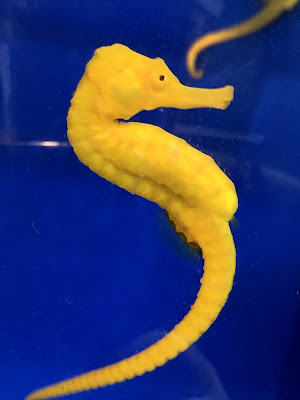The source of sea water to the shore was invested in aquaculture - raising sea life in tanks on shore (albacore, octopus, etc.). Sue Hegland suggested that we visit the sea horse farm so we took the two grandkids who are with us while their mom and dad were biking.
Evidently a problem with sea horses is that salt water hobbyists are fascinated by them, but they starve to death in home salt water tanks for lack of a reasonable food source. You can't just throw some of that flake food into the water and assume the sea horses are fed. Ocean Rider Sea Horse Farm set out to change the habits of sea horses in captivity so that so many would not be taken from the wild for hobbyists. The used the water source near Kona to create a business of raising sea horses and of finding a way to sell "domesticated" stock that would live in a home aquarium. They were successful and now offer tours of their facilities as a way to generate additional income for their nonprofit. The tour is expensive, but the cause is just.
The secret to domestication was to find a way to convince the sea horse to eat a food source available to hobbyists. I raised tropical, not salt water, fish for many years and I was familiar with a food source that was essentially a small frozen slab of a protein source similar to shrimp. This may not have been exactly what they finally used, but it was similar and a source I could understand. The thing was that the sea horses would not originally consume this food source. Sea Horses are carnivores and evidently rather picky. The useful thing is that they are also very social. They placed the desired food source in the tanks and typically nothing happened. By chance, they found one sea horse that would eat the new food (they called it Mikey) and Mikey "taught" the other horses to eat the food. Now, when they have a tank of stock that will not eat the food, they introduce a sea horse from another tank that shows the rest how it is done.
You can order a pair of sea horses from this company. You must purchase a pair because of their social nature with a cost somewhere between $300-500. They will ship to your home. They claimed they required new owners to take a course on sea horse rearing and the link to this online course was on their web site. I could not find it. This seems like one of strategies where an adoption agency of any type requires that your prove you are worthy. Typical commercial pet outlets would not care if their stock made it more than a few weeks in your tank - more business for them. Ocean Rider takes a different approach.






No comments:
Post a Comment